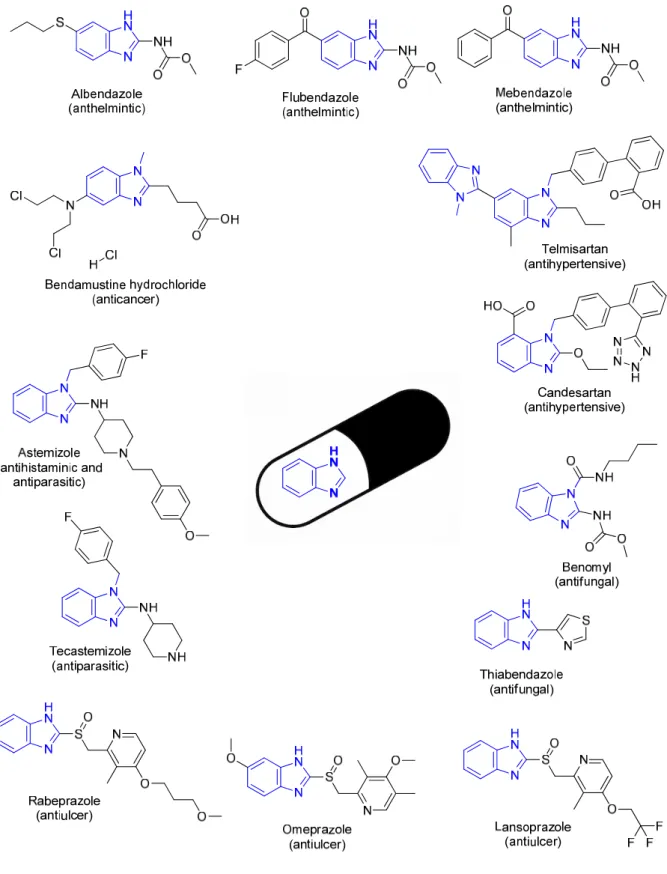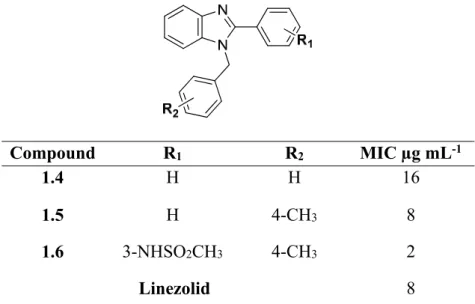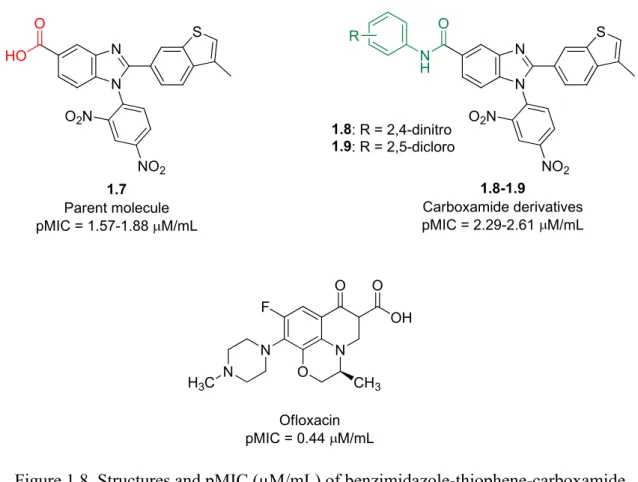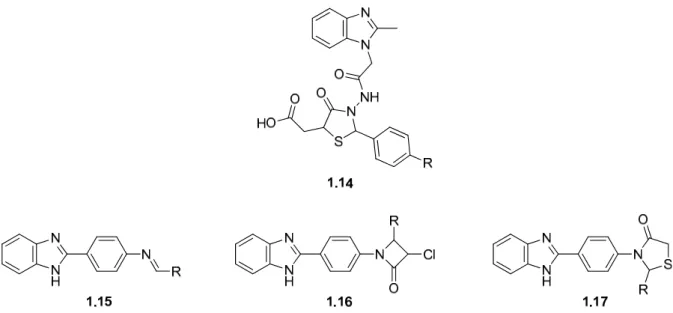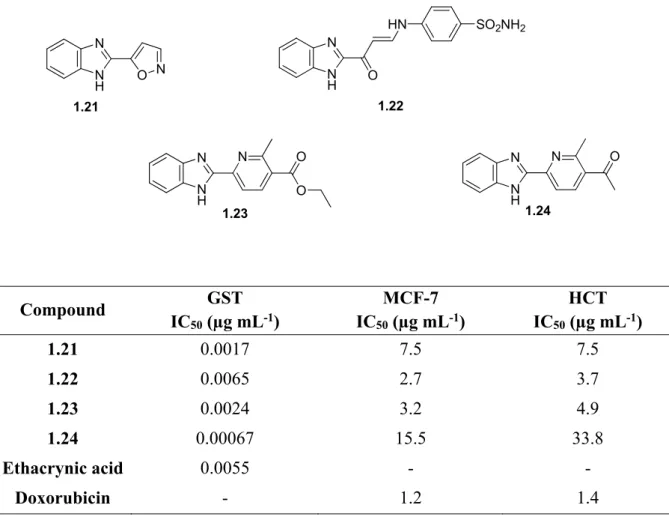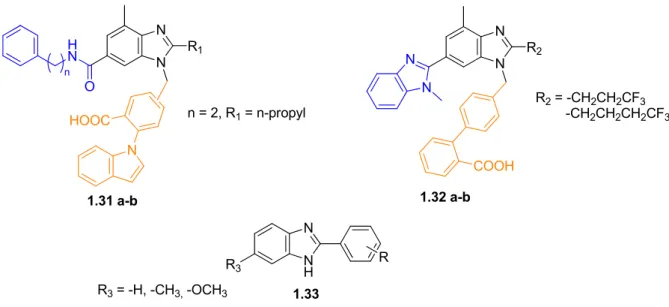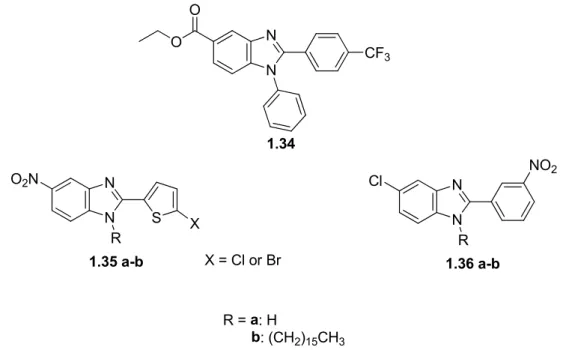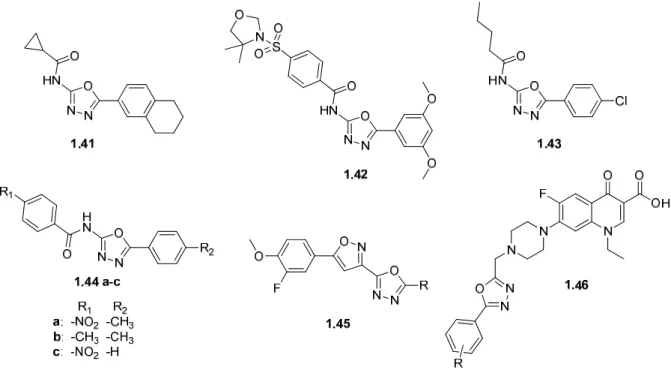Mrs Caryl Janse Van Rensburg for the MH-MS analysis and Dr Mocktar for allowing and training me to carry out the antibacterial studies in your laboratory. 86 Table 2.3 Disc diffusion screening results for the benzimidazole-oxadiazole hybrid molecules and intermediates leading to their synthesis.
Introduction
Antibiotics – antimicrobial resistance and modes of action
A large part of these projects aims to create targets for Gram-negative bacteria (Theuretzbacher et al., 2020). AMR is one of the main reasons why it is difficult to treat infectious diseases such as acute respiratory and meningeal infections, diarrhea and sexually transmitted infections, as there are limited options for treatment (Crowther-Gibson et al., 2011).
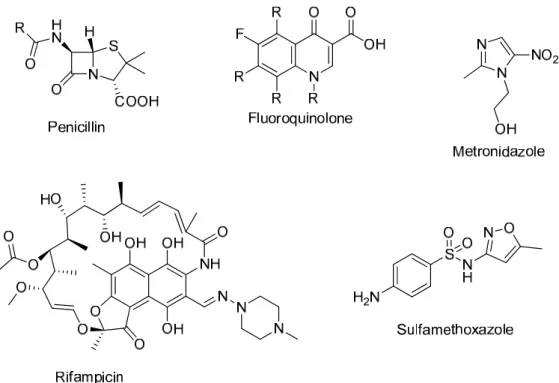
Benzimidazoles
- History and structural features of benzimidazoles
- Synthesis of benzimidazoles
- Bioactivity of benzimidazoles
The synthesis of 2-aminobenzimidazole was performed by reacting o-phenylenediamine with cyanogen bromide in excellent yields (Sethi et al., 2018). Coordination of a copper(I) ion catalyzed the reaction for the intermediate to undergo intramolecular cyclization with elimination of nitrite (NO2-) and regeneration of the copper bromide catalyst, forming 2-arylbenzimidazoles (Sunke et al., 2016; Sayahi etc., 2018) (Scheme 1.17).
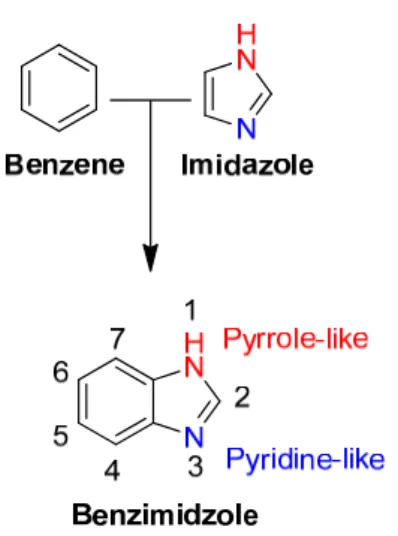
Oxadiazoles
- History and structural features of oxadiazoles
- Synthesis of oxadiazoles
- Bioactivity of oxadiazoles
Using the same reagents, the potential antituberculosis agent 4-(5-mercapto-1,3,4-oxadiazol-2-yl)phenol was synthesized from 4-hydroxybenzohydrazide (Makane et al., 2019). However, no catalyst was required when hypervalent phenyl iododiacetate (PhI(OAc)2) was used (Taha et al., 2019). Some acylhydrazones have undergone dehydrogenative cyclization using a palladium catalyst in the presence of cesium carbonate (Jiang et al., 2018).
Multicomponent reactions (MCR) are considered advantageous over stepwise reactions, in view of the potential to generate several new chemical entities (NCEs) in a one-pot arrangement and are considered to be a more environmentally friendly process (few synthetic steps, energy consumption, and waste generation) (Zhu et al., 2015; John et al., 2021). According to predictive studies, the likely targets for the compounds are through the inhibition of STAT3 and interaction with miR-21 (Stecoza et al., 2021). HIV integrase inhibitors are another approach since the nitrogen atoms in the 1,3,4-oxadiazole moiety are involved in Mg2+ chelation (Alimi Livani et al., 2018; Parizadeh et al., 2018).
Furthermore, these compounds exhibited low cytotoxicity with a reduction in spleen and kidney fungal burden (Capoci et al., 2019).
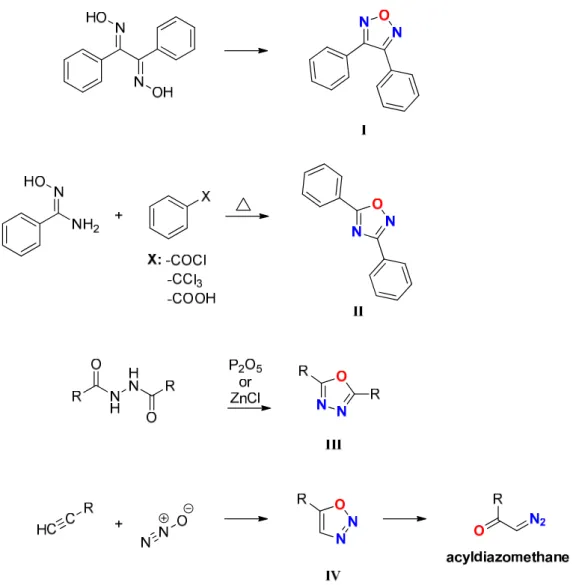
Benzimidazole-oxadiazole hybrids – synthesis and bioactivity
Several benzimidazole-oxadiazoles have been introduced as potential inhibitory agents due to interactions and modes of binding to specific pockets in enzymes. 2016) synthesized hybrids (1.72) that had GSK-3β inhibitory activity with submicromolar IC50 values and showed good antidepressant activity. Benzimidazole-oxadiazoles have been reported to exhibit intense cytotoxic activity on selected cancer cell lines (Acar Çevik et al., 2020; Katikireddy et al., 2021). The compounds (1.73 a-h in Figure 1.32) were determined to be inhibitors of human topoisomerase type I due to interaction with the enzyme DNA topoisomerase I and had similar activity to the known ones.
Benzimidazole-1,3,4-oxadiazole-2-N-alkyl/arylamines with chloro substituents (1,74 a-c) were identified as EGFR inhibitors due to fundamental interactions similar to the standard doxorubicin (Katikireddy et al., 2021).

Hypothesis, aims and objectives
Results and Discussion
Failed and trial reactions
- Benzimidazole dipeptides
- Benzimidazole chalcones
The benzimidazole intermediate A (Scheme 2.1) was then subjected to a much simpler reaction, a Schiff base reaction with benzaldehydes to form imines. It was postulated that the lone pair of electrons on the primary amine was delocalized with the benzimidazole, a highly conjugated system, and as such this lone pair was unavailable for imine formation with aldehydes. It was therefore decided to oxidize the alcohol C (Scheme 2.3) to ketones D with chromium trioxide, which worked well with yields in excess of 80%.
Due to the occurrence of tautomerization, it was necessary to methylate the nitrogen on the benzimidazole scaffold. Even when it was possible to successfully separate one of the para-chlorinated derivatives, the NMR spectra were. The benzimidazole scaffold was constructed by replacing the phenylamine group at position 2 with a trifluoromethyl group, as fluorine atoms are known to enhance certain pharmacokinetic and physiochemical properties—increased metabolic stability, improved membrane permeation (lipophility), and superior binding affinities to target proteins (Shah and Westwell, 2007).
In addition, it was decided to synthesize benzimidazoles from N-substituted-o-phenylenediamines to avoid tautomerization and to use other positions on the benzimidazole for conjugation with other moieties.
Synthesis of benzimidazole oxadiazoles
Efficient cyclization to benzimidazoles 5a-b was not observed with trifluoroacetic acid alone, and a mixture of trifluoroacetic acid and trifluoroacetic anhydride was required for good conversion in 87% and 90% yields, respectively. Twelve benzimidazole-oxadiazole hybrids were successfully synthesized with six benzoic acids using phosphoryl chloride and heating under reflux for 16 h (Scheme 2.5). In general, the yields of the final compounds where an electron-donating methyl or methoxy group was present on the benzoic acid were higher than those where the benzoic acid was unsubstituted or when electron-withdrawing halogens were present.
In general, the melting points for all fluorinated benzimidazole derivatives 7g-7l (those compounds with a para-substituted fluorobenzene ring on the nitrogen of the benzimidazole) were higher than those with an unsubstituted phenyl group on the nitrogen (7a-f), with the exception of 7e (Figure 2.1). For the unsubstituted group (7a-f), the melting point decreased as the size of the halogen on the phenyl group derived from benzoic acid decreased. With the fluorinated compounds (7g-7l), the chloro derivative 7i had the highest melting point, while the bromine and fluorine derivatives (7h and 7j) had similar melting points.
All final benzimidazole-oxadiazole hybrids were elucidated primarily by nuclear magnetic resonance (NMR) spectroscopy (1D and 2D) and confirmed by high-resolution mass spectrometry (HRMS) and elemental analysis.
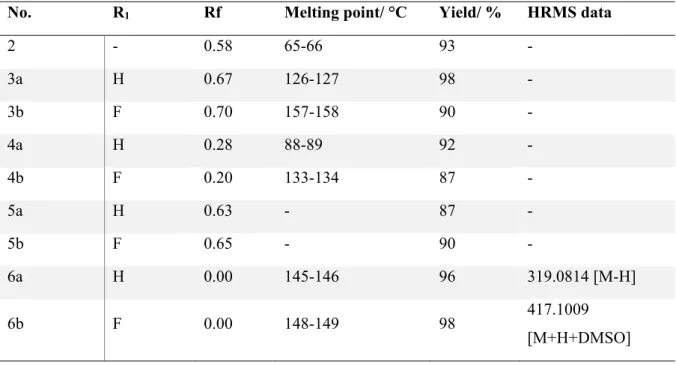
Structural elucidation
- Characterisation of intermediates
- Characterisation of benzimidazole-oxadiazoles hybrids (7a-l)
Reduction of the nitro group was determined by the appearance of the primary amine (H-10) as a two-proton singlet at δ 5.04. Cyclization of the diamine ester with trifluoroacetic acid and trifluoroacetic anhydride led to the formation of the 2-trifluoromethylbenzimidazole 5a, whose 1H NMR spectrum was quite simple and elegant compared to the precursor 4a. When hydrazine converted the benzimidazole ester to the hydrazide 6a, the 1H NMR spectrum was similar to its precursor 5a with the exception of the disappearance of the ester methyl group at δ 3.89 and the appearance of the NH protons on the hydrazide group, a one- proton resonance at δ 9.93 (H-9) and two-proton resonance at δ 4.54 (H-10) (Figure 2.10).
The 13C NMR spectrum of 6a was very similar to 5a with the notable absence of the ester methyl carbon resonance. Interestingly, the carbonyl chemical shift of the acyl hydrazide corresponded to the ester at δ 166 (Figure 2.11). In general, the proton resonances of the benzimidazole aromatic ring were fairly constant in the nitro precursor 3a and the two benzimidazoles 5a and 6a.
The 13C NMR spectrum of 7a showed similar resonances of the benzimidazole and phenyl ring carbon resonances of the precursor 6a.
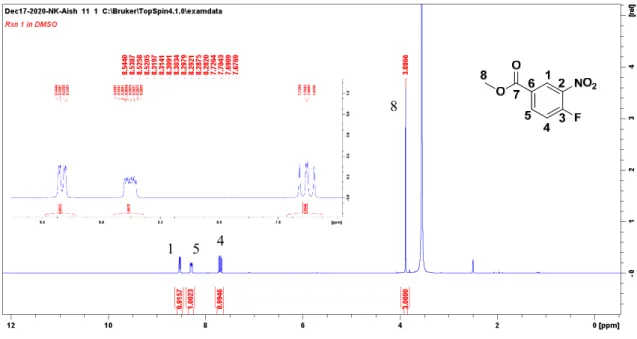
Single Crystal X-Ray Diffraction of compound (7l)
Antibacterial assay of the benzimidazole-oxadiazole hybrids
Five compounds, four of which had electron-donating methyl and methoxy groups on the phenyl ring attached to the oxadiazole moiety. In general, compounds where the phenyl moiety on the benzimidazole ring was fluorinated showed better activity than those that were not. However, the methyl derivative 7e , which showed an MBC of 19 μM, had a significant increase in activity when the phenyl group on the benzimidazole was fluorinated in 7k , increasing.
It is interesting to note that 7a, with no substitution on the phenyl rings in both the benzimidazole and oxadiazole rings was inactive, and that substitution in these rings was necessary for activity against K. These results indicated that in this particular scaffold, a group electron donor in the phenyl moiety attached to the oxadiazole was necessary for good activity, and that a fluorine in the position before the phenyl group attached to the benzimidazole generally increased the activity. The antibacterial study revealed that molecular hybridization of the two pharmacophores produced a compound with improved bioactivity compared to their parent molecules.
It would be interesting to investigate the effect of other substituents on the phenyl group of the benzimidazole in future work.
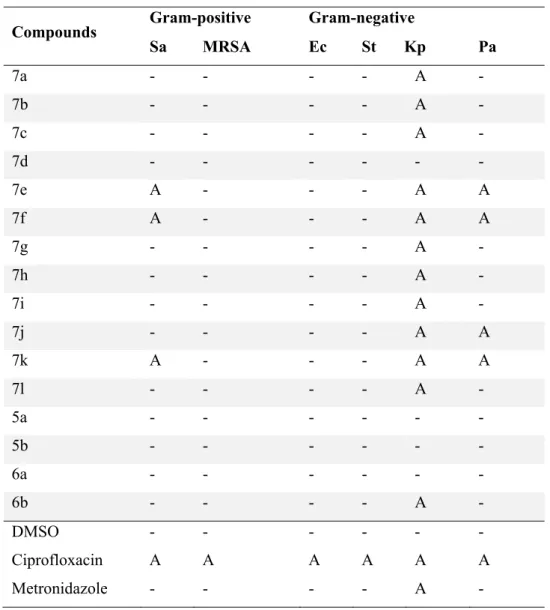
Conclusion and future work
Benzimidazole esters 5a-b and hydrazide intermediates 6a-b are being investigated for their cell viability and cytotoxicity against three cancer cell lines (HepG2, HEK 293 and Caco-2) through the colorimetric 3-(4,5-dimethylthiazol-2-). yl)-2,5-diphenyltetrazolium bromide (MTT) assay. Future work will involve exploring the effect of varying the position of the substituent on the phenyl ring of the benzimidazole and introducing additional groups to the phenyl ring of the oxadiazole. Future work will also involve improving the drug-like qualities of the hit molecule by improving hydrophilicity with the introduction of more polar groups, a sugar molecule or turning it into a salt.
Experimental
General experimental procedures and instrumental techniques
- Nitro group reduction
- Preparation of methyl 1-phenyl-2-(trifluoromethyl)-1H-benzo[d]imidazole-5-
- Synthesis of 1-phenyl-2-(trifluoromethyl)-1H-benzo[d]imidazole-5-
- General procedure of the formation of benzimidazole-oxadiazole hybrids 7a-l
- Preliminary screening
- Minimum bactericidal concentration (MBC) determination
Upon completion, the reaction mixture was poured into an ice slurry and a white precipitate immediately formed. The reaction was stirred under a hydrogen atmosphere for twenty hours 3a or four hours 3b to completion (monitored by TLC). Upon completion, the reaction mixture was filtered through a bed of Celite 545 to remove the Pd/C and the catalyst was deactivated in an acidic medium.
The reaction mixture was then added to 150 mL of water and made alkaline by the addition of sodium hydrogen carbonate (pH 8). After completion, the reaction was basified (pH 8) using sodium hydroxide, extracted with ethyl acetate (3 x 10 mL) and washed with brine (1 x 10 mL). A solution of twelve hybrid molecules 7a-1 and four benzimidazole intermediates was prepared by dissolving 1 mg of the compound in 1 ml of DMSO.
A two-fold serial dilution of partially and fully active compounds was prepared with DMSO to obtain ten (µg/L) standards in triplicate.
Single crystal X-Ray determination
Synthesis, anticancer evaluation and molecular docking studies of novel benzimidazole-1,3,4-oxadiazole derivatives as human topoisomerase type I poisons. An efficient one-pot catalyzed synthesis of 2,5-disubstituted 1,3,4-oxadiazoles and evaluation of their antimicrobial activities. Microwave-assisted synthesis of 1,3,4-oxadiazole-containing benzimidazole derivatives: screening for their in vitro antimicrobial activity.
Iodine-mediated domino-oxidative cyclization: One-pot synthesis of 1,3,4-oxadiazoles via oxidative cleavage of C(sp2)-H or C(sp)-. Synthesis of 7-azaindole-based carbohydrazides and 1,3,4-oxadiazoles; antioxidant activity, α-glucosidase inhibitory properties and docking study. A useful synthesis of 2-acylamino-1,3,4-oxadiazoles from acylthiosemicarbazides using potassium iodate and the discovery of new antibacterial compounds.
Synthesis and spectral-luminescent properties of 2,5-diaryl-1,3,4-oxadiazoles and their chelate complexes with cadmium(II).
Synthesis of dimethylbenzimidazole via cyclisation of acetamide intermediate 14
Condensation reactions with acid anhydrides forming benzimidazoles with o-
Synthesis of benzimidazoles from DMF hydrochloride
Condensation of o-phenylenediamine with amides forming benzimidazoles
Synthetic route to the formation of 2-substituted benzimidazoles using nitriles 21
Synthesis of 1-aminomethylenemalonitrile benzimidazoles using 1H-
Synthesis of 2-amino-5-chlorobenzimidazole sulfonate salts
Thermal decomposition of 5-substituted 1H-tetrazole to 2,5-disubstituted 1,3,4-
Synthesis of 1,3,4-oxadiazoles from the hybridisation of INH with
The pathway for synthesising various benzimidazole hybrid molecules
Synthesis of dipeptides through a solution phase technique
Synthesis scheme to nitrobenzimidazole chalcone derivatives
Synthetic scheme to nitrobenzimidazole-pyrazole hybrids
Synthetic route to benzimidazole-oxadiazole hybrids 7a-l
